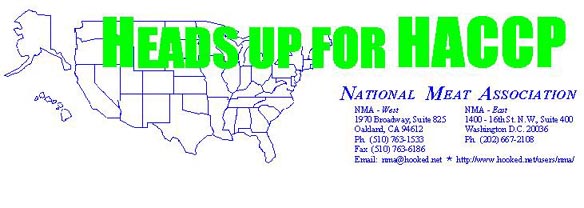

Edited by Jeremy Russell
May 8, 2000
Agency Microbiological Monitoring Programs; What Industry Should Know
Current Agency microbiological monitoring programs test samples of raw finished products such as ground beef, ground chicken, ground turkey or the carcasses of steers/heifers, cows/bulls, hogs, and broilers, for Salmonella and ground beef for E. coli O157:H7. In addition, the Agency�s microbiological monitoring programs also tests ready-to-eat finished products for Listeria monocytogenes, Salmonella, Staphylococcal Enterotoxin and E. coli O157:H7.
NMA has debated the value of the Agency�s end product pathogen sampling programs because they do not address the production processes at a point where results could be used to validate or verify a critical control point. In addition, many of the pathogens tested for by the Agency�s monitoring programs have a low incidence rate and do not lend themselves for use as food safety barometers.
The Agency�s public commitment to continue testing end products for the presence of pathogens has challenged industry managers with the prospect of eventuality addressing confirmed findings of a pathogen on their product. Confirmed positive results could initiate product recalls, agency press releases, and enforcement actions ranging from the issuance of non-compliance reports to withholding actions and possibly the suspension of inspection. For example, FSIS Directive 5000.1 indicates that noncompliance with the Salmonella performance standards or Listeria monocytogenes in ready-to-eat products may constitute a failure to maintain an adequate HACCP plan.
The following information has been compiled to help members become aware that they are operating in a strict regulatory environment, where their product must comply with the Agency�s microbiological programs. However, keep in mind that different sampling programs require the application of different strategies:
It is important that you try to follow the above steps to minimize the likelihood of an incorrect test result or an unnecessary recall.
How long does it take to run tests on the sample that the inspector has sent in? Use the following chart as a guide:
|
Product |
Type of Test |
Days for Negative or Presumptive Positive |
Days to Confirm |
|
RTE |
Salmonella (rapid test) |
2 Days** |
5-7 Days Minimum |
|
RTE |
Salmonella (conventional test) |
4 Days** |
6-7 Days Minimum |
|
RTE |
Listeria |
24-48 Hours** |
5-7 Days Minimum |
|
Ground |
E. coli O157:H7 |
24 Hours** |
5 Days Minimum |
|
**Not including mailing time. |
|||
If your results haven�t come back in the above number of days, check with your FSIS District Office for a status update or contact NMA�s Regulatory Staff for assistance.
FSIS provides several alternatives to mailing you your lab results. One such alternative is an e-mail distribution system that can cut down mailing time. FSIS is revising its email system and you may experience delays in receiving results. However, once completed, e-mail distribution might be an excellent alternative to mailing. Forms are available upon request; please contact NMA�s regulatory staff at (510) 763-1533.
*NOTE: Except in the case of regulatory compliance or Salmonella performance standards, in which a lot should not be held.